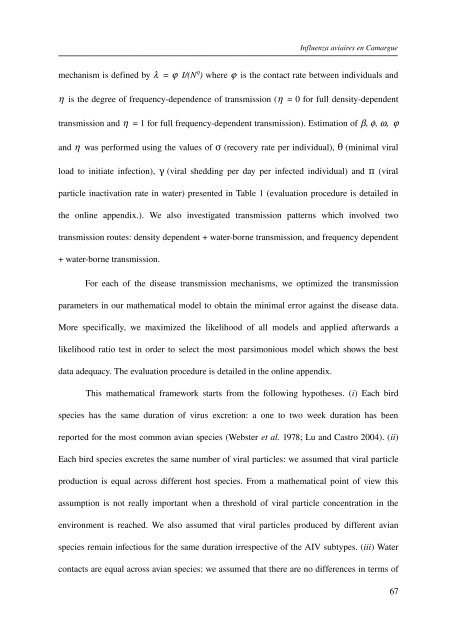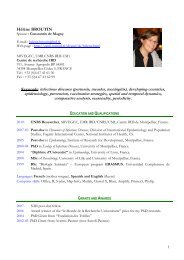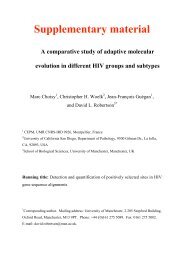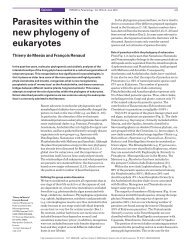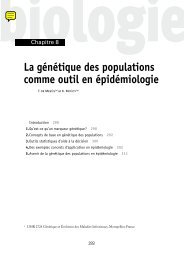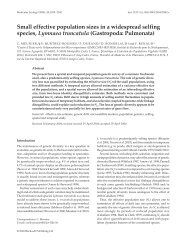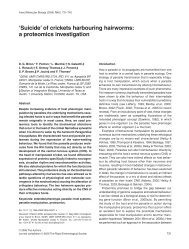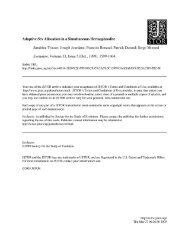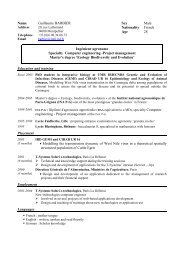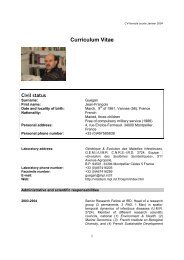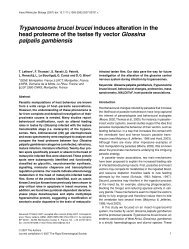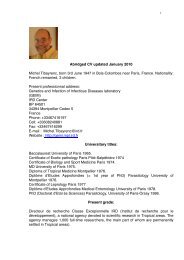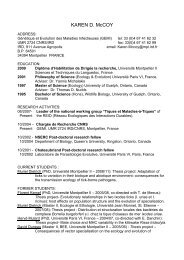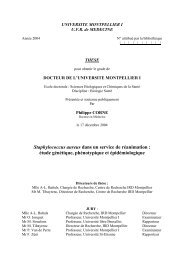écologie des virus influenza aviaires en Camargue - IRD
écologie des virus influenza aviaires en Camargue - IRD
écologie des virus influenza aviaires en Camargue - IRD
You also want an ePaper? Increase the reach of your titles
YUMPU automatically turns print PDFs into web optimized ePapers that Google loves.
Influ<strong>en</strong>za <strong>aviaires</strong> <strong>en</strong> <strong>Camargue</strong>mechanism is defined by = I/(N ) where is the contact rate betwe<strong>en</strong> individuals and is the degree of frequ<strong>en</strong>cydep<strong>en</strong>d<strong>en</strong>ce of transmission ( = 0 for full d<strong>en</strong>sitydep<strong>en</strong>d<strong>en</strong>ttransmission and = 1 for full frequ<strong>en</strong>cydep<strong>en</strong>d<strong>en</strong>t transmission). Estimation of , , , and was performed using the values of σ(recovery rate per individual), θ(minimal viralload to initiate infection), γ(viral shedding per day per infected individual) andπ(viralparticle inactivation rate in water) pres<strong>en</strong>ted in Table 1 (evaluation procedure is detailed inthe online app<strong>en</strong>dix.). We also investigated transmission patterns which involved twotransmission routes: d<strong>en</strong>sity dep<strong>en</strong>d<strong>en</strong>t + waterborne transmission, and frequ<strong>en</strong>cy dep<strong>en</strong>d<strong>en</strong>t+ waterborne transmission.For each of the disease transmission mechanisms, we optimized the transmissionparameters in our mathematical model to obtain the minimal error against the disease data.More specifically, we maximized the likelihood of all models and applied afterwards alikelihood ratio test in order to select the most parsimonious model which shows the bestdata adequacy. The evaluation procedure is detailed in the online app<strong>en</strong>dix.This mathematical framework starts from the following hypotheses. (i) Each birdspecies has the same duration of <strong>virus</strong> excretion: a one to two week duration has be<strong>en</strong>reported for the most common avian species (Webster et al. 1978; Lu and Castro 2004). (ii)Each bird species excretes the same number of viral particles: we assumed that viral particleproduction is equal across differ<strong>en</strong>t host species. From a mathematical point of view thisassumption is not really important wh<strong>en</strong> a threshold of viral particle conc<strong>en</strong>tration in the<strong>en</strong>vironm<strong>en</strong>t is reached. We also assumed that viral particles produced by differ<strong>en</strong>t avianspecies remain infectious for the same duration irrespective of the AIV subtypes. (iii) Watercontacts are equal across avian species: we assumed that there are no differ<strong>en</strong>ces in terms of67


